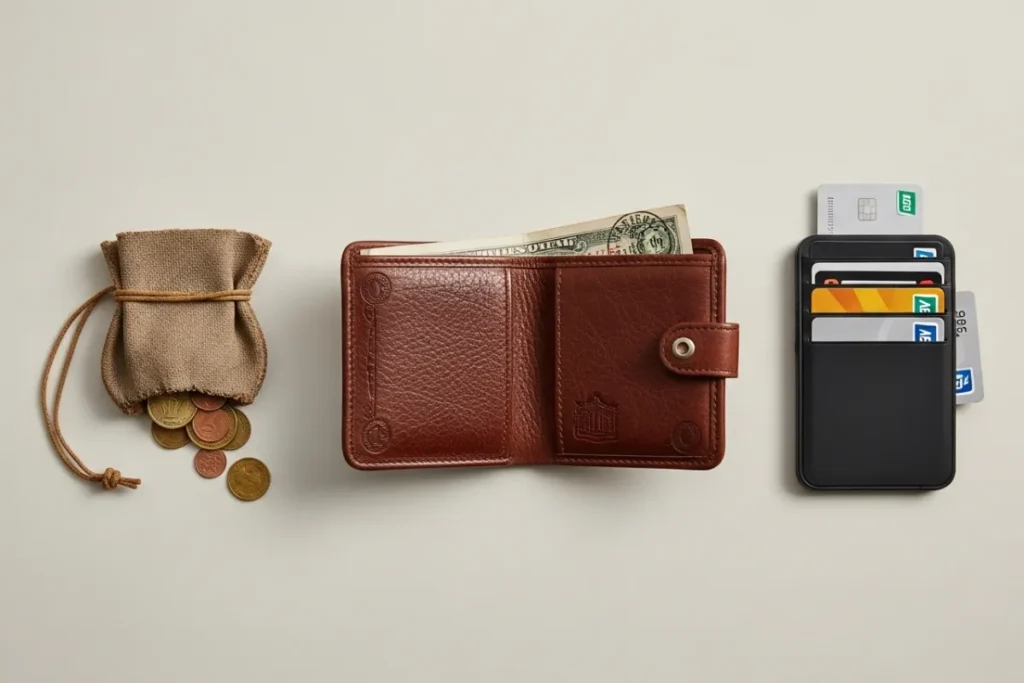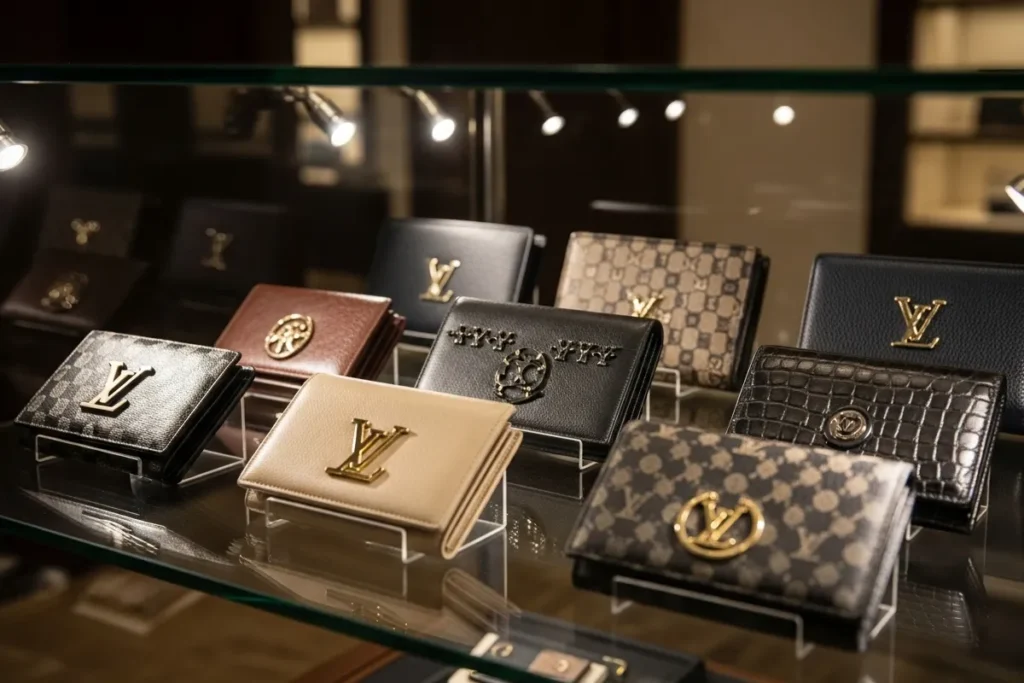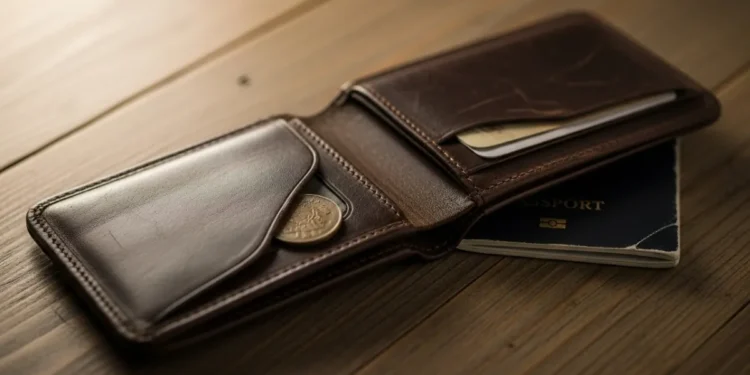Unpack the surprising history of the wallet. From coin pouches to crypto, discover how this small object became a powerful symbol of status and identity.
Table of Contents
Introduction
The history of the wallet is a story of profound social anxiety. We pretend it’s a simple tool, a neutral vessel for carrying currency and cards, but that has never been true. From its very first incarnation as a humble pouch tied to a belt, this small, personal object has been less about containment and more about broadcast. It is a carefully managed performance, a physical token designed to answer a series of silent, urgent questions: Am I prepared? Do I have access? Am I trustworthy? To understand this object is to understand that for millennia, we have carried our social legitimacy in our pockets, a constant, tangible weight of belonging.
This small container has served as a perfect mirror, reflecting our society’s most significant shifts in commerce, class, and the very concept of identity. Every change in its design was a direct response to a major disruption—the invention of paper money, the explosion of consumer credit, and now, the dematerialization of value itself into data. The wallet is a silent narrator of our economic lives, tracking the visible and invisible lines of wealth from the clink of ancient coins to the sterile tap of a smartphone. Unpacking the complete history of the wallet is to trace how we have defined and displayed status across time.
This essay will follow that complex evolution through five distinct acts. We will begin with the ancient pouch, a tool for survival that quickly became the first token of social participation. We will then examine how the gentleman’s bifold emerged to accommodate paper money, transforming the wallet into an accessory of class. Next, we will explore the credit card revolution, which turned the wallet into a dense packet of personal identity, before analyzing the recent minimalist correction as a design-led rejection of that clutter. Finally, we will arrive at the present moment: the wallet as a ghost in the machine, an invisible app that forces us to ask what happens when our most potent symbol of identity vanishes entirely.
The Pouch and the Pilgrim: The Ancient Roots of the Wallet’s History
To begin a proper history of the wallet, we must first abandon the image of a stitched leather bifold. The wallet’s story does not start in a gentleman’s breast pocket but on the hip of a Greek traveler or a Roman merchant. Its earliest ancestor was the simple pouch: the Greek kibisis or the Roman loculi, humble sacks of leather or cloth tied to a girdle.
These were not specialized objects for currency alone but pragmatic vessels for survival, carrying coins, flint, dried food, and personal amulets. This initial chapter reveals that the fundamental history of the wallet is one of mobility, establishing a direct link between what a person could carry and their ability to engage with the world through trade, travel, and pilgrimage.
This ancient history of the wallet is not merely theoretical; it has a tangible, frozen beginning. Discovered high in the Alps, the 5,300-year-old mummy known as Ötzi the Iceman wore a calf-leather belt pouch containing a scraper, a drill, and a flint flake—a prehistoric toolkit. While devoid of coins, Ötzi’s pouch serves as a powerful artifact, demonstrating that the wallet’s primary function was once inseparable from life itself. This early chapter in the history of the wallet shows that its core purpose was utility, linking carrying capacity directly to one’s ability to survive and adapt. It provides a stark, material baseline for the entire evolution to follow.
From these utilitarian roots, the pouch quickly evolved into the first “identity token.” A full, heavy pouch did more than just signal wealth; it broadcast preparedness, status, and trustworthiness. It showed that its owner was not a vagrant but a participant in the social and economic fabric of their community. In this sense, rethinking the history of the wallet reveals that it was never just a passive container. From its inception, it was an active social signal, a visible line drawn between those who had resources and those who did not. The social consequences of the history of the wallet were embedded from its very first form.

The Gentleman’s Fold: How Paper Money Rewrote the History of the Wallet
For centuries, the pouch reigned supreme, its simple, sack-like form going largely unchallenged. That changed with the widespread adoption of paper currency in the Western world, starting around the 17th century. Suddenly, the drawstring pouch became an awkward, inefficient vessel. It creased and damaged delicate banknotes, and its bulky shape was ill-suited for the crisp, flat profile of this new form of money. This technological leap in commerce created a design crisis, forcing a necessary and dramatic evolution that would fundamentally rewrite the material history of the wallet from a universal carryall into a stratified object of class.
The answer was the flat case wallet, an object designed not for the belt but for the pocket. Specifically, it was engineered to slip discreetly into the inner breast pocket of a gentleman’s tailored suit. This pivotal moment in wallet design history marked a clear social divergence. The sophisticated bifold became the accessory of the urban elite—merchants, aristocrats, and professionals—while the working class and rural populations continued to use simpler pouches or merely folded notes in a pocket. The wallet was no longer just a tool; it was an integral part of a wardrobe, a quiet testament to one’s station and sartorial refinement.
This new form cemented the wallet’s role as a potent status symbol, communicating wealth not through its contents but through its very design. The quality of the Spanish leather, the precision of the stitching, and the slimness of its profile became the new vocabulary of class distinction. The act of retrieving it was a quiet performance of sophistication. This was a critical turning point in the long history of the wallet, where the object’s primary function shifted from simple utility to the subtle, powerful expression of social standing. Rethinking the history of the wallet from this point forward requires us to see it as a carefully curated social script.
The Credit Card Revolution: The Wallet as a Token of Identity and Access
If paper money forced the first great redesign in the wallet’s evolution, the plastic rectangle of the credit card triggered its most significant internal crisis. The mid-20th-century boom in consumer credit demanded a radical re-engineering of the wallet’s interior, shifting the focus from billfolds to a cascade of card slots. This period represents a flawed history of the wallet in one sense; while it promised frictionless commerce, it birthed the infamous “bulky wallet” problem. The sleek gentleman’s fold was gone, replaced by an overstuffed leather brick that strained pocket seams, a direct consequence of a design that prioritized access to debt.
More profoundly, this era transformed the wallet from a money-carrier into an identity-packet. The most important items it held were no longer currency but tokens of official personhood: the driver’s license, the social security card, insurance cards, and photos of loved ones. The wallet became a condensed biography, a physical ledger of one’s access, privileges, and responsibilities within modern society. Losing your wallet was no longer just a financial setback; it was an existential crisis, a temporary erasure of self. This is a critical juncture in the history of wallets and identity, where the object became a proxy for the person.
This cultural moment found its ultimate, comical avatar in the exploding wallet of Seinfeld‘s George Costanza, a monstrous collection of receipts, ticket stubs, and countless cards. It was a punchline, but it was also a perfect cultural artifact. His wallet was a physical manifestation of a life overstuffed with financial entanglements, social obligations, and the accumulated debris of consumerism. This overstuffed relic provides a rich text for understanding the anxieties and realities that this chapter in the modern history of the wallet represents—the peak of its physical importance right before its inevitable digital dematerialization.

The Minimalist Correction: Design and the Rejection of the Bulky Past
Just as the overstuffed wallet reached its physical and cultural breaking point, a powerful counter-movement emerged. The early 21st century saw a design-led rebellion against the leather brick, championed by brands like Bellroy, Ridge, and Secrid. This was a direct, aesthetic, and functional rejection of the excesses of the credit card era—a conscious effort to refine and rethink the history of the wallet. The goal was surgical: to strip the wallet down to its essential components, eliminating every unnecessary fold, pocket, and millimeter of thickness. This minimalist correction wasn’t just about size; it was an ideological statement against decades of accumulated clutter.
This shift in wallet design history did not happen in a vacuum. It perfectly mirrored broader cultural trends obsessed with optimization and curation. Influenced by the “life-hacking” ethos of Silicon Valley and the decluttering gospel of Marie Kondo, the minimalist wallet became a tool for a streamlined life. A slim profile signaled a person in control—someone who had edited their financial life down to the essentials. This chapter in the history of the wallet shows the object becoming an accessory for a curated personal brand, reflecting a desire for efficiency and a rejection of the perceived chaos of the past.
Of course, the performance of status did not disappear; it simply changed its language. The symbol of wealth was no longer the quantity of cards in a thick fold but the quality and curation of a hyper-efficient object. High-tech materials like carbon fiber, aerospace-grade aluminum, and ethically sourced leathers became the new signifiers of taste and discernment. The minimalist wallet proved that the most constant thread in the long history of the wallet is its ability to adapt its role as a social signal. The message shifted from “I have access to everything” to “I have access to only what matters.”
The Ghost in the Machine: The Wallet’s Disappearance and Digital Future
The final, and perhaps most profound, chapter in this long narrative is happening now: the wallet is becoming a ghost. Its physical form is dissolving into software, dematerializing into the encrypted files of Apple Pay, Google Wallet, and decentralized crypto wallets. This move from pocket to pixel represents the most radical shift yet in the history of the wallet. The object that began as a tangible pouch for survival is now an invisible string of data, an application residing on the same device we use for communication, entertainment, and work. This is not merely an evolution; it is a transfiguration.
This digital wallet transition forces a critical question that cuts to the core of this entire history: when the wallet is invisible, how is status signaled? The answer, it seems, is that the container has become the content. The premium smartphone itself—the latest iPhone or flagship Android, perhaps adorned with a designer case—is the new wallet and, therefore, the new status object. The performance of wealth is no longer the quiet reveal of a fine leather bifold but the seamless, almost arrogant, convenience of a tap-to-pay transaction. The social consequences of the history of the wallet are clear: the signal has simply migrated to the device that hosts it.
In this transition, something is irrevocably lost even as immense convenience is gained. We sacrifice the tangible, tactile connection to our financial identity—the worn leather, the faded photos, the ticket stubs acting as a personal archive—for unparalleled efficiency and security. Biometrics and encryption have made our financial lives safer than ever, yet also more sterile and disconnected from physical reality. This moment brings the entire history of the wallet to a critical, uncertain precipice, leaving us to wonder what it means when an object so central to our identity simply vanishes.

Conclusion
The long history of the wallet confirms it was never a neutral object. From its most ancient form as a simple pouch tied to a girdle, its purpose was twofold: to ensure survival by carrying essentials and to signal one’s ability to participate in society. This foundational chapter established the wallet not merely as a container for value, but as the first physical token of trustworthiness and economic standing. It began its life already speaking a quiet language of social distinction, a function it would refine over millennia but never truly abandon.
Over the centuries, this object’s form was dictated by the very nature of money itself. The shift from coin to paper currency created the discreet gentleman’s fold, a powerful symbol of class and sophistication. The subsequent explosion of consumer credit then bloated this sleek accessory into a dense brick of identity—a packet of plastic cards, licenses, and personal mementos that defined one’s access to the modern world. In these physical forms, the wallet reached the peak of its expressive power, broadcasting a complex story of status, debt, and personal history from the seams of a pocket.
The recent minimalist correction and the final, radical leap into digital invisibility have only reinforced this central truth. From a simple pouch to an invisible app, the history of the wallet serves as a perfect mirror, reflecting our society’s evolving definitions of value, trust, and identity. Its journey proves that we have always needed a token to display our place in the world. The form of that token changes—from a heavy pouch to a slim aluminum case to a premium smartphone—but its fundamental social function remains remarkably, stubbornly, the same. As this essential object finally dissolves into the cloud, the critical question is not what it was, but what new language it will speak about us next.







